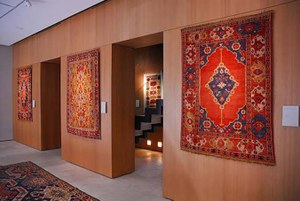Moshe Tabibnia Gallery
Located in the heart of Milan, the Moshe Tabibnia Gallery holds a treasure trove of woven textile art. The collection is made up of carpets, tapestries and woven textiles from various weaving countries and ages, and offers the opportunity to scholars, enthusiasts and customers to experience and explore the world of woven textile art.
Keir Collection
The Keir Collection was amassed by Edmund de Unger, a Hungarian who fled Budapest in 1949 following a series of arrests and moved permanently to England, working first as a manservant. After further training, he entered the legal profession as a barrister. He later worked as Crown Counsel in Ghana for the Colonial Office. The period in West Africa permitted visits to Egypt, where he developed an interest in Coptic and Islamic art. On returning to England, de Unger became a property developer, which provided him with the means to build up his post-war art collection, which he named the "Keir Collection", after one of his first homes The Keir on Wimbledon Common in London.
The ever-increasing Keir Collection was moved in the late 1960s to his house in Ham, Surrey. The collection, which started in his youth with carpets, gradually grew to include ceramics, in particular rare items of lustreware from Mesopotamia, Persian and Moghul miniatures, medieval and Renaissance enamels, sculptures, and textiles from Italy and France (including the medieval enamels collection of Ernst and Martha Kofler-Truniger). Widely knowledgeable on the area in which he collected, de Unger founded the Islamic Art Circle in 1964 and lectured frequently on his expertise all over the world.
The majority of carpets that form the core of the Keir Collection remain in the 18th century Manor House on Ham Street in Richmond, London, which was de Unger's home up to his death in 2011. A small but representative portion of classical oriental carpets from Persia, Turkey and Mughal India are on display in the Dallas Museum of Arts.
Gulbenkian Collection
Calouste Sarkis Gulbenkian was a businessman and philanthropist of British nationality and Armenian origin. Through the oil industry Mr Gulbenkian amassed a fortune and an art collection which he kept in a private museum at his Paris house. An art expert said in a 1950 issue of Life magazine that "Never in modern history has one man owned so much." While Gulbenkian's art collection may be found in many museum across the world, most of his art is exhibited at the Museu Calouste Gulbenkian in Lisbon, Portugal. The museum was founded according to his will, in order to accommodate and display his collection, now belonging to the Calouste Gulbenkian Foundation. Of the roughly 6,000 items in the museum's collections, a selection of around 1000 is on permanent display.
David Collection
The David Collection is a museum of fine and applied art in Copenhagen, Denmark, built around the private collections of lawyer, businessman and art collector C. L. David. The museum is particularly noted for its collection of Islamic art from the 8th to the 19th century, which is one of the largest in Northern Europe. The museum also holds fine and applied art from Europe in the 18th century and the Danish Golden Age as well as a small collection of Danish early modern art. All the works of art in the collection of Danish early modern art were acquired by C. L. David himself.
Aga Khan Museum
The Aga Khan Museum is a museum of Islamic art, Iranian (Persian) art and Muslim culture in the North York district of Toronto, Ontario, Canada. The museum is an initiative of the Aga Khan Trust for Culture, an agency of the Aga Khan Development Network. It houses collections of Islamic art and heritage, including artifacts from the private collections of His Highness the Aga Khan, the Institute of Ismaili Studies in London, and Prince and Princess Sadruddin Aga Khan, which showcase the artistic, intellectual and scientific contributions of Muslim civilizations. The museum is dedicated to the acquisition, preservation, display and interpretation of artefacts relating to the intellectual, cultural, artistic and religious traditions of Muslim communities, past and present. Artefacts include ceramics, metalwork, and paintings covering all periods of Islamic history. Manuscripts in the collection include the earliest known copy of Avicenna's Qanun fi'l-Tibb (“The Canon of Medicine") dated 1052.



